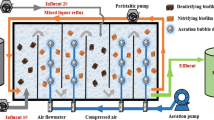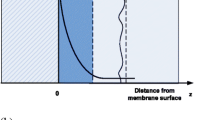Abstract
Nitrogen removal performance and nitrifying population dynamics were investigated in a redox stratified membrane biofilm reactor (RSMBR) under oxygen limited condition to treat ammonium-rich wastewater. When the NHt +4 -N loading rate increased from 11.1±1.0 to 37:2 ± 3:2 gNHt +4 -N·m−2·d−1, the nitrogen removal in the RSMBR system increased from 18.0±9.6 mgN·d−1 to 128.9±61.7 mgN·d−1. Shortcut nitrogen removal was achieved with nitrite accumulation of about 22:3 ± 5:3 mgNO −2 -N·L−1. Confocal micrographs showed the stratified distributions of nitrifiers and denitrifiers in the membrane aerated biofilms (MABs) at day 120, i.e., ammonia and nitrite oxidizing bacteria (AOB and NOB) were dominant in the region adjacent to the membrane, while heterotrophic bacteria propagated at the top of the biofilm. Real-time qPCR results showed that the abundance of amoA gene was two orders of magnitude higher than the abundance of nxrA gene in the MABs. However, the nxrA gene was always detected during the operation time, which indicates the difficulty of complete washout of NOB in MABs. The growth of heterotrophic bacteria compromised the dominance of nitrifiers in biofilm communities, but it enhanced the denitrification performance of the RSMBR system. Applying a high ammonia loading together with oxygen limitation was found to be an effective way to start nitrite accumulation in MABs, but other approaches were needed to sustain or improve the extent of nitritation in nitrogen conversion in MABs.
Similar content being viewed by others
References
Smith V H, Tilman G D, Nekola J C. Eutrophication: impacts of excess nutrient inputs on freshwater, marine, and terrestrial ecosystems. Environmental Pollution, 1999, 100(1–3): 179–196
Hellinga C, Schellen A A J C, Mulder J W, van Loosdrecht M C M, Heijnen J J. The SHARON process: An innovative method for nitrogen removal from ammonium-rich waste water. Water Science and Technology, 1998, 37(9): 135–142
Ahn Y H. Sustainable nitrogen elimination biotechnologies: a review. Process Biochemistry, 2006, 41(8): 1709–1721
Peng Y Z, Zhu G B. Biological nitrogen removal with nitrification and denitrification via nitrite pathway. Applied Microbiology and Biotechnology, 2006, 73(1): 15–26
Sinha B, Annachhatre A P. Partial nitrification—operational parameters and microorganisms involved. Reviews in Environmental Science and Biotechnology, 2007, 6(4): 1569–1705
Guo J, Wang S, Huang H, Peng Y, Ge S, Wu C, Sun Z. Efficient and integrated start-up strategy for partial nitrification to nitrite treating low C/N domestic wastewater. Water Science and Technology, 2009, 60(12): 3243–3251
Jubany I, Lafuente J, Baeza J A, Carrera J. Total and stable washout of nitrite oxidizing bacteria from a nitrifying continuous activated sludge system using automatic control based on Oxygen Uptake Rate measurements. Water Research, 2009, 43(11): 2761–2772
Jenicek P, Svehla P, Zabranska J, Dohanyos M. Factors affecting nitrogen removal by nitritation/denitritation. Water Science and Technology, 2004, 49(5–6): 73–79
Aslan S, Miller L, Dahab M. Ammonium oxidation via nitrite accumulation under limited oxygen concentration in sequencing batch reactors. Bioresource Technology, 2009, 100(2): 659–664
Anthonisen A C, Loehr R C, Prakasam T B, Srinath E G. Inhibition of nitrification by ammonia and nitrous acid. Journal — Water Pollution Control Federation, 1976, 48(5): 835–852
Kim D J, Lee D I, Keller J. Effect of temperature and free ammonia on nitrification and nitrite accumulation in landfill leachate and analysis of its nitrifying bacterial community by FISH. Bioresource Technology, 2006, 97(3): 459–468
Van Hulle S W H, Volcke E I P, Teruel J L, Donckels B, van Loosdrecht M C M, Vanrolleghem P A. Influence of temperature and pH on the kinetics of the Sharon nitritation process. Journal of Chemical Technology and Biotechnology (Oxford, Oxfordshire), 2007, 82(5): 471–480
van Kempen R, ten Have C C R, Meijer S C F, Mulder J W, Duin J O J, Uijterlinde C A, van Loosdrecht M C M. SHARON process evaluated for improved wastewater treatment plant nitrogen effluent quality. Water Science and Technology, 2005, 52(4): 55–62
Gali A, Dosta J, van Loosdrecht M C M, Mata-Alvarez J. Two ways to achieve an anammox influent from real reject water treatment at lab-scale: Partial SBR nitrification and SHARON process. Process Biochemistry, 2007, 42(4): 715–720
Pochana K, Keller J. Study of factors affecting simultaneous nitrification and denitrification. Water Science and Technology, 1999, 39(6): 61–68
Ciudad G, González R, Bornhardt C, Antileo C. Modes of operation and pH control as enhancement factors for partial nitrification with oxygen transport limitation. Water Research, 2007, 41(20): 4621–4629
Brindle K, Stephenson T, Semmens M J. Nitrification and oxygen utilisation in a membrane aeration bioreactor. Journal of Membrane Science, 1998, 144(1–2): 197–209
Suzuki Y, Hatano N, Ito S, Ikeda H. Performance of nitrogen removal and biofilm structure of porous gas permeable membrane reactor. Water Science and Technology, 2000, 41(4–5): 211–217
Hsieh Y L, Tseng S K, Chang Y J. Nitrification using polyvinyl alcohol-immobilized nitrifying biofilm on an O2-enriching membrane. Biotechnology Letters, 2002, 24(4): 315–319
Semmens M J, Dahm K, Shanahan J, Christianson A. COD and nitrogen removal by biofilms growing on gas permeable membranes. Water Research, 2003, 37(18): 4343–4350
Terada A, Hibiya K, Nagai J, Tsuneda S, Hirata A. Nitrogen removal characteristics and biofilm analysis of a membrane-aerated biofilm reactor applicable to high-strength nitrogenous wastewater treatment. Journal of Bioscience and Bioengineering, 2003, 95(2): 170–178
Satoh H, Ono H, Rulin B, Kamo J, Okabe S, Fukushi K. Macroscale and microscale analyses of nitrification and denitrification in biofilms attached on membrane aerated biofilm reactors. Water Research, 2004, 38(6): 1633–1641
Walter B, Haase C, Räbiger N. Combined nitrification/denitrification in a membrane reactor. Water Research, 2005, 39(13): 2781–2788
Terada A, Yamamoto T, Igarashi R, Tsuneda S, Hirata A. S. T and Hirata A. Feasibility of a membrane-aerated biofilm reactor to achieve controllable nitrification. Biochemical Engineering Journal, 2006, 28(2): 123–130
Downing L S, Nerenberg R. Performance and microbial ecology of the hybrid membrane biofilm process for concurrent nitrification and denitrification of wastewater. Water Science and Technology, 2007, 55(8–9): 355–362
Syron E, Casey E. Membrane-aerated biofilms for high rate biotreatment: performance appraisal, engineering principles, scale-up, and development requirements. Environmental Science & Technology, 2008, 42(6): 1833–1844
Hwang J H, Cicek N, Oleszkiewicz J A. Membrane biofilm reactors for nitrogen removal: state-of-the-art and research needs. Water Science and Technology, 2009, 60(11): 2739–2747
Wang R, Terada A, Lackner S, Smets B F, Henze M, Xia S, Zhao J. Nitritation performance and biofilm development of co- and counter-diffusion biofilm reactors: modeling and experimental comparison. Water Research, 2009, 43(10): 2699–2709
Terada A, Lackner S, Tsuneda S, Smets B F. Redox-stratification controlled biofilm (ReSCoBi) for completely autotrophic nitrogen removal: the effect of co- versus counter-diffusion on reactor performance. Biotechnology and Bioengineering, 2007, 97(1): 40–51
Gong Z, Liu S, Yang F, Bao H, Furukawa K. Characterization of functional microbial community in a membrane-aerated biofilm reactor operated for completely autotrophic nitrogen removal. Bioresource Technology, 2008, 99(8): 2749–2756
LaPara TM, Cole A C, Shanahan JW, Semmens MJ. The effects of organic carbon, ammoniacal-nitrogen, and oxygen partial pressure on the stratification of membrane-aerated biofilms. Journal of Industrial Microbiology & Biotechnology, 2006, 33(4): 315–323
Feng Y J, Tseng S K, Hsia T H, Ho C M, Chou W P. Partial nitrification of ammonium-rich wastewater as pretreatment for anaerobic ammonium oxidation (Anammox) using membrane aeration bioreactor. Journal of Bioscience and Bioengineering, 2007, 104(3): 182–187
Hwang J H, Cicek N, Oleszkiewicz J A. Achieving biofilm control in a membrane biofilm reactor removing total nitrogen. Water Research, 2010, 44(7): 2283–2291
Amann R I, Ludwig W, Schleifer K H. Phylogenetic identification and in situ detection of individual microbial cells without cultivation. Microbiological Reviews, 1995, 59(1): 143–169
Geets J, de Cooman M, Wittebolle L, Heylen K, Vanparys B, De Vos P, Verstraete W, Boon N. Real-time PCR assay for the simultaneous quantification of nitrifying and denitrifying bacteria in activated sludge. Applied Microbiology and Biotechnology, 2007, 75(1): 211–221
Rotthauwe J H, Witzel K P, Liesack W. The ammonia mono-oxygenase structural gene amoA as a functional marker: molecular fine-scale analysis of natural ammonia-oxidizing populations. Applied and Environmental Microbiology, 1997, 63(12): 4704–4712
Wertz S, Poly F, Le Roux X, Degrange V. Development and application of a PCR-denaturing gradient gel electrophoresis tool to study the diversity of Nitrobacter-like nxrA sequences in soil. FEMS Microbiology Ecology, 2008, 63(2): 261–271
Schramm A, De Beer D, Wagner M, Amann R. Identification and activities in situ of Nitrosospira and Nitrospira spp. as dominant populations in a nitrifying fluidized bed reactor. Applied and Environmental Microbiology, 1998, 64(9): 3480–3485
Cole A C, Semmens M J, LaPara T M. Stratification of activity and bacterial community structure in biofilms grown on membranes transferring oxygen. Applied and Environmental Microbiology, 2004, 70(4): 1982–1989
Vázquez-Padín J, Mosquera-Corral A, Campos J L, Méndez R, Revsbech N P. Microbial community distribution and activity dynamics of granular biomass in a CANON reactor. Water Research, 2010, 44(15): 4359–4370
Li T, Bai R, Liu J. Distribution and composition of extracellular polymeric substances in membrane-aerated biofilm. Journal of Biotechnology, 2008, 135(1): 52–57
Bell A, Aoi Y, Terada A, Tsuneda S, Hirata A. Comparison of spatial organization in top-down- and membrane-aerated biofilms: a numerical study. Water Science and Technology, 2005, 52(7): 173–180
Wyffels S, Boeckx P, Pynaert K, Zhang D, Van Cleemput O, Chen G, Verstraete W. Nitrogen removal from sludge reject water by a two-stage oxygen-limited autotrophic nitrification denitrification process. Water Science and Technology, 2004, 49(5–6): 57–64
Sliekers A O, Haaijer S C M, Stafsnes M H, Kuenen J G, Jetten M S M. Competition and coexistence of aerobic ammonium-and nitrite-oxidizing bacteria at low oxygen concentrations. Applied Microbiology and Biotechnology, 2005, 68(6): 808–817
Blackburne R, Yuan Z G, Keller J. Partial nitrification to nitrite using low dissolved oxygen concentration as the main selection factor. Biodegradation, 2008, 19(2): 303–312
Yamamoto T, Takaki K, Koyama T, Furukawa K. Novel partial nitritation treatment for anaerobic digestion liquor of swine wastewater using swim-bed technology. Journal of Bioscience and Bioengineering, 2006, 102(6): 497–503
Villaverde S, Fdz-Polanco F, Garca P A. Nitrifying biofilm acclimation to free ammonia in submerged biofilters. Start-up influence. Water Research, 2000, 40(2): 602–610
Author information
Authors and Affiliations
Corresponding author
Rights and permissions
About this article
Cite this article
Wang, R., Zhan, X., Zhang, Y. et al. Nitrifying population dynamics in a redox stratified membrane biofilm reactor (RSMBR) for treating ammonium-rich wastewater. Front. Environ. Sci. Eng. China 5, 48–56 (2011). https://doi.org/10.1007/s11783-011-0305-7
Received:
Accepted:
Published:
Issue Date:
DOI: https://doi.org/10.1007/s11783-011-0305-7




